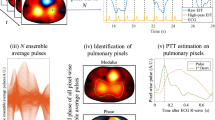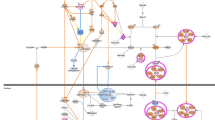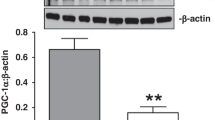Abstract
Endothelin-1 can cause pulmonary vasoconstriction via endothelin-A (ETA) receptor activation. We hypothesized that ETA blockers (EMD 122946 and BQ 610) would reduce hypoxia-induced (HYP) but not group B streptococcal infusion (GBS)-induced pulmonary hypertension in a juvenile whole animal model. Pulmonary hypertension was created by exposing chronically instrumented piglets to HYP (n = 12) or heat-killed GBS (n = 11). ETA blockade was produced by increasing bolus doses of EMD122946 or BQ 610. Pulmonary arterial pressure (PAP), systemic arterial pressure (SAP), left atrial pressure, central venous pressure, and cardiac output were continuously measured. Pulmonary and systemic vascular resistance indices (PVRI and SVRI) were calculated. HYP doubled PAP and PVRI. Both ETA blockers decreased PAP and PVRI in a dose-dependent manner in HYP, with high doses decreasing PVRI to baseline and reducing PAP by 50%. GBS also doubled both PAP and PVRI. EMD 122946 did not change PAP or PVRI in GBS, although BQ 610 markedly increased PVRI (>100% increase with 0.15 mg/kg) and showed a trend toward increasing PAP. Both models showed minimal (<25%) changes in SAP or SVRI. Neither ETA blocker changed baseline hemodynamics in the absence of HYP or GBS. Pao2 did not change with GBS but decreased with BQ 610. ETA receptor blockade attenuated hypoxic, but not GBS induced pulmonary hypertension. BQ 610 worsened PVRI and oxygenation in the GBS model. Differences in response to ETA blockade in pulmonary hypertension may be seen depending on the etiology (hypoxia versus infection-associated), and the specific ETA antagonist used.
Similar content being viewed by others
Log in or create a free account to read this content
Gain free access to this article, as well as selected content from this journal and more on nature.com
or
Abbreviations
- CI:
-
cardiac index
- ET-1:
-
endothelin-1
- GBS:
-
group B streptococcus
- NO:
-
nitric oxide
- PAP:
-
mean pulmonary arterial pressure
- PPHN:
-
persistent pulmonary hypertension of the newborn
- PVRI:
-
pulmonary vascular resistance index
- SAP:
-
mean systemic arterial pressure
- SVRI:
-
systemic vascular resistance index
References
Walsh-Sukys MC 1993 Persistent pulmonary hypertension of the newborn. The black box revisited. Clin Perinatol 20: 127–143
Goodman G, Perkin RM, Anas NG, Sperling DR, Hicks DA, Rowen M 1988 Pulmonary hypertension in infants with bronchopulmonary dysplasia. J Pediatr 112: 67–71
Wong J, Vanderford PA, Fineman JR, Chang R, Soifer SJ 1993 Endothelin-1 produces pulmonary vasodilation in the intact newborn lamb. Am J Physiol 265: H1318–1325
Bradley LM, Czaga JF, Goldstein RE 1990 Circulatory effects of endothelin-1 in newborn piglets. Am J Physiol 259: H1613–1617
Barnard JW, Barman SA, Adkins WK, Longnecker GL, Taylor AE 1991 Sustained effects of endothelin-1 on rabbit, dog, and rat pulmonary circulation. Am J Physiol 261: H479–486
Ziegler JW, Ivy DD, Kinsella JP, Abman SH 1995 The role of nitric oxide, endothelin, and prostaglandins in the transition of the pulmonary circulation. Clin Perinatol 22: 387–402
Rosenberg AA, Kennaugh J, Koppenhafer SL, Loomis M, Chatfield BA, Abman SH 1993 Elevated immunoreactive endothelin-1 levels in newborn infants with persistent pulmonary hypertension. J Pediatr 123: 109–114
Kumar P, Kazzi NJ, Shankaran S 1996 Plasma immunoreactive endothelin-1 concentrations in infants with persistent pulmonary hypertension of the newborn. Am J Perinatol 13: 335–341
Macdonald PD, Paton RD, Logan RW, Skeoch CH, Davis CF 1999 Endothelin-1 levels in infants with pulmonary hypertension receiving extracorporeal membrane oxygenation. J Perinat Med 27: 216–220
Allen SW, Chatfield BA, Koppenhafer SA, Schaffer MS, Wolfe RR, Abman SH 1993 Circulating immunoreactive endothelin-1 in children with pulmonary hypertension. Association with acute hypoxic pulmonary vasoreactivity. Am Rev Respir Dis 148: 519–522
Noguchi Y, Hislop AA, Haworth SG 1997 Influence of hypoxia on endothelin-1 binding sites in neonatal porcine pulmonary vasculature. Am J Physiol 272: H669–678
Soukka H, Jalonen J, Kero P, Kaapa P 1998 Endothelin-1, atrial natriuretic peptide and pathophysiology of pulmonary hypertension in porcine meconium aspiration. Acta Paediatr 87: 424–428
Wong J, Reddy VM, Hendricks-Munoz K, Liddicoat JR, Gerrets R, Fineman JR 1995 Endothelin-1 vasoactive responses in lambs with pulmonary hypertension and increased pulmonary blood flow. Am J Physiol 269: H1965–1972
Oparil S, Chen SJ, Meng QC, Elton TS, Yano M, Chen YF 1995 Endothelin-A receptor antagonist prevents acute hypoxia-induced pulmonary hypertension in the rat. Am J Physiol 268: L95–100
Tilton RG, Munsch CL, Sherwood SJ, Chen SJ, Chen YF, Wu C, Block N, Dixon RA, Brock TA 2000 Attenuation of pulmonary vascular hypertension and cardiac hypertrophy with sitaxsentan sodium, an orally active ET(A) receptor antagonist. Pulm Pharmacol Ther 13: 87–97
DiCarlo VS, Chen SJ, Meng QC, Durand J, Yano M, Chen YF, Oparil S 1995 ETA-receptor antagonist prevents and reverses chronic hypoxia-induced pulmonary hypertension in rat. Am J Physiol 269: L690–697
Medbo S, Tollofsrud PA, Saugstad OD 1999 Pulmonary hemodynamics in newborn piglets during hypoxemia and reoxygenation: blocking of the endothelin-1 receptors. Pediatr Res 46: 514–522
Tarpey MN, Graybar GB, Lyrene RK, Godoy G, Oliver J, Gray BM, Philips JB 1987 Thromboxane synthesis inhibition reverses group B Streptococcus-induced pulmonary hypertension. Crit Care Med 15: 644–647
Philips JB, Li JX, Gray BM, Pritchard DG, Oliver JR 1992 Role of capsule in pulmonary hypertension induced by group B streptococcus. Pediatr Res 31: 386–390
LeCras TD, McMurtry IF 2001 Nitric oxide production in the hypoxic lung. Am J Physiol Lung Cell Mol Physiol 280: L575–582
Villamor E, Perez Vizcaino F, Tamargo J, Moro M 1996 Effects of group B Streptococcus on the responses to U46619, endothelin-1, and noradrenaline in isolated pulmonary and mesenteric arteries of piglets. Pediatr Res 40: 827–833
Vila JM, Medina P, Segarra G, Aldasoro M, Noguera I, Lluch S 2001 Endothelin-1-induced potentiation of adrenergic responses in the rabbit pulmonary artery: role of thromboxane A(2). Eur J Pharmacol 413: 247–254
Schmect J, Krafft P, Groschler A, Heller A, Neuhof H, van Ackern K, Koch T 1999 Characterization and distribution of endothelin receptors in the pulmonary circulation: investigation of isolated, perfused, and ventilated rabbit lungs. Shock 12: 247–254
Chua CC, Hamdy RC, Chua BH 1996 Regulation of endothelin-1 production by a thromboxane A2 mimetic in rat heart smooth muscle cells. Biochim Biophys Acta 1313: 1–5
Wanecek M, Oldner A, Rudehill A, Sollevi A, Alving K, Weitzberg E 1999 Endothelin(A)-receptor antagonism attenuates pulmonary hypertension in porcine endotoxin shock. Eur Respir J 13: 145–151
Snapper JR, Thabes JS, Lefferts PL, Lu W 1998 Role of endothelin in endotoxin-induced sustained pulmonary hypertension in sheep. Am J Respir Crit Care Med 157: 81–88
Wong J, Vanderford PA, Fineman JR, Soifer SJ 1994 Developmental effects of endothelin-1 on the pulmonary circulation in sheep. Pediatr Res 36: 394–401
Ambalavanan N, St John E, Carlo WA, Bulger A, Philips JB 2002 Feasibility of nitric oxide administration by oxygen hood in neonatal pulmonary hypertension. J Perinatol 22: 50–56
Perreault T, Berkenbosch JW, Barrington KJ, Decker ER, Wu C, Brock TA, Baribeau J 2001 TBC3711, an ET(A) receptor antagonist, reduces neonatal hypoxia-induced pulmonary hypertension in piglets. Pediatr Res 50: 374–383
Nelin LD, Thomas CJ, Dawson CA 1996 Effect of hypoxia on nitric oxide production in neonatal pig lung. Am J Physiol 271: H8–14
Mederski WW, Dorsch D, Osswald M, Anzali S, Christadler M, Schmitges CJ, Schelling P, Wilm C, Fluck M 1998 Endothelin antagonists: discovery of EMD 122946, a highly potent and orally active ETA selective antagonist. Bioorg Med Chem Lett 8: 1771–1776
Medbo S, Yu XQ, Asberg A, Saugstad OD 1998 Pulmonary hemodynamics and plasma endothelin-1 during hypoxemia and reoxygenation with room air or 100% oxygen in a piglet model. Pediatr Res 44: 843–849
Perreault T, Stewart DJ, Cernacek P, Wu X, Ni F, De Marte J, Giaid A 1993 Newborn piglet lungs release endothelin-1: effect of alpha-thrombin and hypoxia. Can J Physiol Pharmacol 71: 227–233
Burkhardt M, Barton M, Shaw SG 2000 Receptor- and non-receptor-mediated clearance of big-endothelin and endothelin-1: differential effects of acute and chronic ETA receptor blockade. J Hypertens 18: 273–279
Wong J, Vanderford PA, Winters JW, Chang R, Soifer SJ, Fineman JR 1993 Endothelin-1 does not mediate acute hypoxic vasoconstriction in the intact newborn lamb. J Cardiovasc Pharmacol 22: S262–266
Holm P, Liska J, Franco-Cereceda A 1998 The ETA receptor antagonist, BMS-182874, reduces acute hypoxic pulmonary hypertension in pigs in vivo. Cardiovasc Res 37: 765–771
Luscher TF, Barton M 2000 Endothelins and endothelin receptor antagonists: therapeutic considerations for a novel class of cardiovascular drugs. Circulation 102: 2434–2440
Love MP, McMurray JJ 2001 Endothelin receptor antagonists and cardiovascular diseases of aging. Drugs Aging 18: 425–440
Acknowledgements
EMD122946 was provided by Merck KGaA, Darmstadt, Germany.
Author information
Authors and Affiliations
Corresponding author
Additional information
Presented in part at the Pediatric Academic Societies' Meeting, Baltimore, Maryland, U.S.A., April–May 2001.
Rights and permissions
About this article
Cite this article
Ambalavanan, N., Philips, J., Bulger, A. et al. Endothelin-A Receptor Blockade in Porcine Pulmonary Hypertension. Pediatr Res 52, 913–921 (2002). https://doi.org/10.1203/00006450-200212000-00017
Received:
Accepted:
Issue date:
DOI: https://doi.org/10.1203/00006450-200212000-00017
This article is cited by
-
Endothelin receptor antagonist attenuates inflammatory response and prolongs the survival time in a neonatal sepsis model
Intensive Care Medicine (2010)
-
Intravenous tezosentan improves gas exchange and hemodynamics in acute lung injury secondary to meconium aspiration
Intensive Care Medicine (2008)



